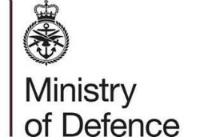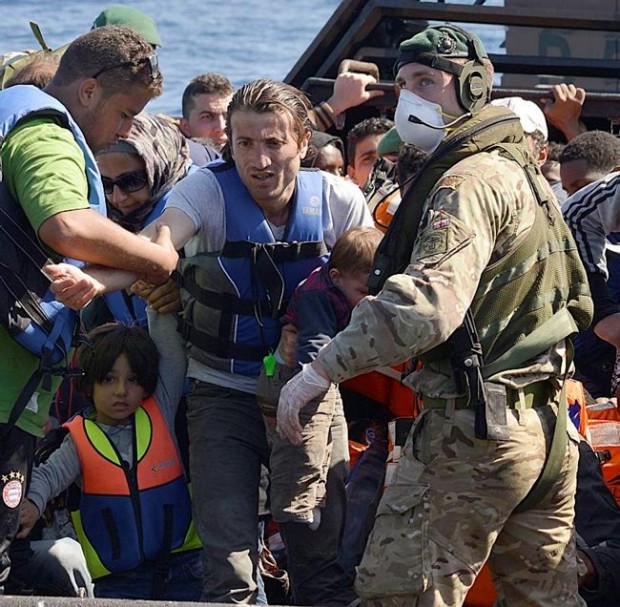In defence news this morning, broadcasters cover the story that HMS Bulwark rescued hundreds of migrants from the Mediterranean.
HMS Bulwark
The Royal Navy has saved nearly 400 migrants - including 50 small children - who were found crammed into a wooden boat in the Mediterranean. The Daily Mail, Daily Telegraph and Daily Express report how HMS Bulwark intercepted the endangered ship as it attempted to cross waters north of Libya, dispatching five landing craft to its aid. Defence Secretary Michael Fallon said HMS Bulwark and her crew had once again saved hundreds of lives in the crisis, offering medical assistance, food, water and dry clothes to those in need. He added that a wider political solution is required, but that does not detract from yesterday’s rescue at sea.
Defence spending
A number of papers including The Sun and The Daily Mail report on speculation that military chiefs have been told to slash the defence budget by £1billion in a move that could hit operations overseas. According to The Times, George Osborne is seeking to cut the budgets of most Government departments this year by an extra 5% in a move that raises the chances of Britain missing the NATO minimum target of 2% of national income on defence. It says the Treasury has told most government departments to find savings amounting to £3 billion or more before the budget on July 8. It goes on to say that senior military figures confirmed that they were searching for savings on this scale, though they said that no formal demand had been made. Con Coughlin, in The Telegraph, questions whether this really is a good time for more defence cuts, saying the Chancellor should be following the example of Germany and France who have allocated extra funds for defence.
A MOD spokesperson said:
The Ministry of Defence continuously looks for ways to be more efficient and is on track to deliver over £5 billion of savings since 2010. In the context of the Spending Review and SDSR we are looking at where further efficiencies could be delivered. We are confident that we will spend 2% of GDP on defence in this financial year. The Prime Minister has also made clear that there will be an annual 1% real terms increase in spending on defence equipment throughout this parliament.
Trident
The Financial Times and The Times report on Alex Salmond’s warnings that it would be a “fatal mistake” for the UK Government to proceed with its plan to renew Trident, refusing to rule out calling a second referendum if it does so. Salmond issued his warning during a Commons debate over allegations made by a Royal Navy “whistleblower" about the security of the missiles at the Faslane base in Scotland. Defence Secretary Michael Fallon dismissed the concerns in a statement yesterday saying they were mostly either “factually incorrect or the result of mis- or partial understanding”.
He added:
Having now completed our investigation, and having consulted with the appropriate regulatory and operating authorities, I can assure the House that neither the operational effectiveness of our Continuous at Sea Deterrent nor the safety of our submariners or members of the public have been compromised.
Navy exercise
The Daily Telegraph reports that three Royal Navy warships and 170 British soldiers will next month take part in a Baltic exercise designed to reassure the region that NATO will protect it from Vladmir Putin. HMS Ocean, a helicopter carrier and HMS Iron Duke, a Type 23 frigate, will join HMS Quorn for the annual exercise.
Defence Secretary Michael Fallon said:
The key role that our Armed Forces will play in the Allied Shield exercises clearly demonstrates our commitment to defending our NATO allies and partners. Operating alongside other nations’ forces on land, sea, and in the air, we are able to enhance our ability to conduct joint operations now and in the future, and respond to any threat to the Alliance. These exercises are just the latest examples of the UK’s ongoing contribution to the reassurance, training, and defence of our Eastern European NATO allies. Following the deployment of RAF Typhoons on the Baltic Air Policing mission, and the Army’s participation in Estonia’s largest ever military exercise earlier this month, the UK will continue to play a key role in the collective defence of NATO countries.
HMT LANCASTRIA
HMT LANCASTRIA was sunk by enemy action on 17 June 1940 while engaged in the evacuation of British troops from France; more than three thousand men lost their lives. The wreck lies in French waters off the port of St Nazaire. The Times and BBC Online write that campaigners, as well as relatives of those who died, want the wreck to be formally designated a war grave. They say the situation has been made worse for the victims' families as they believe some documentary evidence about the disaster is being withheld. The BBC acknowledges that the MOD said all contemporary documents relating to the sinking were in the public domain. The MOD has only withheld a small number of recent documents relating to internal correspondence, as is common practice. The term “war grave” refers to land burials only - the MOD refers to vessels which sank with loss of life as “military maritime graves” to distinguish them from graves on land. The MOD regards the LANCASTRIA as being a “military maritime grave”. In 2006 the French authorities agreed to protect the wreck under French law which forbids recreational diving on the wreck site. The names of the merchant seaman crew who lost their lives are commemorated on the Tower Hill Memorial at Trinity Square and on the appropriate Service memorial. The Commonwealth War Graves Commission maintains the graves of more than 1,000 of those who perished as a result of the sinking; additionally there is a wooden plaque in the church of St Katherine Cree, near Fenchurch Street Station, and the LANCASTRIA is also represented at the National Memorial Arboretum in Staffordshire, by a Sessile Oak tree and a plaque.
A MOD spokesperson said:
The sinking of the HMT LANCASTRIA remains the United Kingdom’s greatest maritime disaster and, although it occurred over 70 years ago, the sacrifice of many thousands of servicemen and civilians, and the endurance of those who were saved that day, must never be forgotten. All known MOD records relating to the LANCASTRIA have been available at the National Archives at Kew since the early 1970s. As the French Government has provided an appropriate level of protection to the LANCASTRIA through French law and it is formally considered a military maritime grave by the MOD, we believe that the wreck has the formal status and protection it deserves.
Image of the day
Migrants are led to safety from their stricken craft to a Landing craft from HMS Bulwark in the Central Mediterranean.
The Fleet Flagship has once again played a leading role in an international rescue of hundreds of migrants from their stricken craft in the Central Mediterranean.
Follow us on Twitter and don’t forget to sign up for email alerts.

